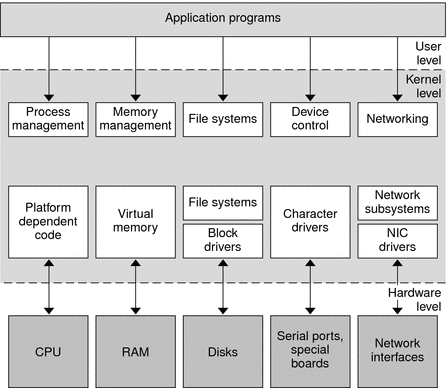|
|||
|
Part I Designing Device Drivers for the Solaris Platform 1. Overview of Solaris Device Drivers 2. Solaris Kernel and Device Tree 5. Managing Events and Queueing Tasks 7. Device Access: Programmed I/O 10. Mapping Device and Kernel Memory 14. Layered Driver Interface (LDI) Part II Designing Specific Kinds of Device Drivers 15. Drivers for Character Devices 18. SCSI Host Bus Adapter Drivers 19. Drivers for Network Devices Part III Building a Device Driver 21. Compiling, Loading, Packaging, and Testing Drivers 22. Debugging, Testing, and Tuning Device Drivers 23. Recommended Coding Practices B. Summary of Solaris DDI/DKI Services C. Making a Device Driver 64-Bit Ready |
What Is the Kernel?The Solaris kernel is a program that manages system resources. The kernel insulates applications from the system hardware and provides them with essential system services such as input/output (I/O) management, virtual memory, and scheduling. The kernel consists of object modules that are dynamically loaded into memory when needed. The Solaris kernel can be divided logically into two parts: the first part, referred to as the kernel, manages file systems, scheduling, and virtual memory. The second part, referred to as the I/O subsystem, manages the physical components. The kernel provides a set of interfaces for applications to use that are accessible through system calls. System calls are documented in section 2 of the Reference Manual Collection (see Intro(2)). Some system calls are used to invoke device drivers to perform I/O. Device drivers are loadable kernel modules that manage data transfers while insulating the rest of the kernel from the device hardware. To be compatible with the operating system, device drivers need to be able to accommodate such features as multithreading, virtual memory addressing, and both 32-bit and 64-bit operation. The following figure illustrates the kernel. The kernel modules handle system calls from application programs. The I/O modules communicate with hardware. Figure 2-1 Solaris Kernel The kernel provides access to device drivers through the following features:
Multithreaded Execution EnvironmentThe Solaris kernel is multithreaded. On a multiprocessor machine, multiple kernel threads can be running kernel code, and can do so concurrently. Kernel threads can also be preempted by other kernel threads at any time. The multithreading of the kernel imposes some additional restrictions on device drivers. For more information on multithreading considerations, see Chapter 3, Multithreading. Device drivers must be coded to run as needed at the request of many different threads. For each thread, a driver must handle contention problems from overlapping I/O requests. Virtual MemoryA complete overview of the Solaris virtual memory system is beyond the scope of this book, but two virtual memory terms of special importance are used when discussing device drivers: virtual address and address space.
Devices as Special FilesDevices are represented in the file system by special files. In the Solaris OS, these files reside in the /devices directory hierarchy. Special files can be of type block or character. The type indicates which kind of device driver operates the device. Drivers can be implemented to operate on both types. For example, disk drivers export a character interface for use by the fsck(1) and mkfs(1) utilities, and a block interface for use by the file system. Associated with each special file is a device number (dev_t). A device number consists of a major number and a minor number. The major number identifies the device driver associated with the special file. The minor number is created and used by the device driver to further identify the special file. Usually, the minor number is an encoding that is used to identify which device instance the driver should access and which type of access should be performed. For example, the minor number can identify a tape device used for backup and can specify that the tape needs to be rewound when the backup operation is complete. DDI/DKI InterfacesIn System V Release 4 (SVR4), the interface between device drivers and the rest of the UNIX kernel was standardized as the DDI/DKI. The DDI/DKI is documented in section 9 of the Reference Manual Collection. Section 9E documents driver entry points, section 9F documents driver-callable functions, and section 9S documents kernel data structures used by device drivers. See Intro(9E), Intro(9F), and Intro(9S). The DDI/DKI is intended to standardize and document all interfaces between device drivers and the rest of the kernel. In addition, the DDI/DKI enables source and binary compatibility for drivers on any machine that runs the Solaris OS, regardless of the processor architecture, whether SPARC or x86. Drivers that use only kernel facilities that are part of the DDI/DKI are known as DDI/DKI-compliant device drivers. The DDI/DKI enables you to write platform-independent device drivers for any machine that runs the Solaris OS. These binary-compatible drivers enable you to more easily integrate third-party hardware and software into any machine that runs the Solaris OS. The DDI/DKI is architecture independent, which enables the same driver to work across a diverse set of machine architectures. Platform independence is accomplished by the design of DDI in the following areas:
|
||
|